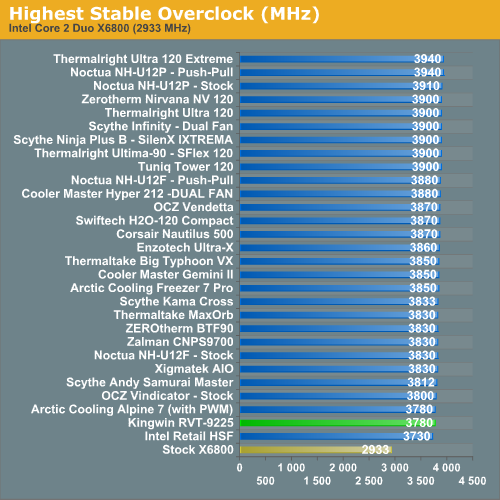Kingwin RVT-9225: Budget priced cooling results in budget performance
by Matt Campbell on July 16, 2008 2:00 AM EST- Posted in
- Cases/Cooling/PSUs
Overclocking
Some users buy aftermarket coolers to quiet down their system, but many are seeking performance gains in the area of overclocking. In the days of shoddy Intel HSFs, a quality aftermarket cooler could equal double-digit percentage gains. As we've mentioned previously, Intel's current incarnation is quite good, but gains can still be significant. Let's see how the RVT-9225 stacks up. Again, the same processor and settings are used for all cooling tests for consistency.

The Kingwin RVT-9225 just barely scrapes a lead over the Intel unit with a maximum stable speed of 3.78GHz. This is disappointing, particularly as the noise level is so much higher than the competing units.
Performance Scaling
Performance scaling is shown below - keep in mind that lower is better in this case. As mentioned the maximum overclocks top out at 3.78GHz, but we file this under "3.83GHz" (rounding up).
 |
Again, we see what seems to be a theme: the RVT-9225 tracks the Intel unit almost exactly. It only ekes out a slight win at 3.33GHz.
Load conditions are a good indicator of cooling performance, and as we've said in the past, a flatter line here is better versus a steep slope (indicating that the cooler cannot effectively handle the load it's being presented with).
 |
There's no real news here. We see almost a mirror image of the Intel retail HSF, with a slight win at 3.33GHz only.










34 Comments
View All Comments
brian_riendeau - Monday, July 21, 2008 - link
I blame the push pin mounting. Push pins such enough as it is, and from the looks of it, they put the fan on first, then installed the push pins by wedging a finger between the fan and the pin itself. That is just not good form for mounting a cooler, probably just one of the pins is "locked" in place but not actually in all the way causing uneven pressure and ridiculous temps.flopsie - Monday, July 21, 2008 - link
hmm... i got 2 of these cuz they were 15 bucks, and put on on my dual athlon 64 4200, and one on my core quad 6600. the athlon machine saw the cpu temp drop 9 degrees c, while the intel one only dropped about 3 degrees. it could easily be that those plastic tabs on the intel style mounts just dont supply enough positive pressure.Dark Legion - Saturday, July 19, 2008 - link
Hmm...I see under test configuration that the ASUS silent square pro cooler was supposed to be included in this review, and yet it wasn't. The list in test configuration also seemed to have more coolers than the benchmarks, so I'm sure there were more that were skipped. Can we possibly see the benchmarks for the rest of these coolers?flashbacck - Wednesday, July 16, 2008 - link
Are those ambient noise readings correct? Ambient noise of ~38 db is pretty loud.Bieszczad - Wednesday, July 16, 2008 - link
Well, with the reported temperatures so high, the fan needs to spin really fast to remove the heat, hence the noise.CoreTemp misbehaving? Bad diode on the motherboard and/or processor?
Flaky BIOS?
Anyway, those temp and noise numbers stink.
flashbacck - Thursday, July 17, 2008 - link
yeah, but it says ambient noise was measured at 38 db which should be with all systems off, or with only a passive cpu cooler on the setup. Either way, it's too loud.Baked - Wednesday, July 16, 2008 - link
From the charts it looks like the reviewer did a bad installation of the heatsink. It's very common for push pin heatsink to have improper installation, especially if people are too lazy to take out the entire motherboard for installation. I know, I did this with the arctic cooling freezer pro 7. You can't just slap the heatsink into position and push the pins in and call it proper. There's not enough clearance between the mobo and mobo tray for you to do that, and you'll just get the pins bent. You have to take the mobo out, make sure there's enough clearance behind the mobo, set the heatsink in place, and make sure the pins are properly threaded through the mounting holes, locked, and secured. You might need 3 hands for the installation if you're one of those clumpsy people.Even with the poorly finished heatsink surface, the temperature shouldn't but that bad. It's obvious one or more corners of the heatsink is lifted during testing due to improper installation. I suggest the reviewer redo the testing using the proper installation method I mentioned above.
major_major - Wednesday, July 16, 2008 - link
Who knows what went wrong with the testing methodology...but I think we can all conclude that there is no way those numbers are correct. Besides, any heatsink review where the Arctic Cooling Freezer 7 Pro places 2nd place in load cooling temps is automatically suspect.JarredWalton - Wednesday, July 16, 2008 - link
Load temperatures at stock clock speeds on a dual-core CPU are hardly that demanding. That the Freezer 7 Pro has a higher minimum fan speed could easily account for its placement. Look at the overclocking and scaling charts, and of the tested HSFs the Freezer 7 Pro places in the middle of the pack.biassj - Wednesday, July 16, 2008 - link
Don't confuse this one with it's bigger brother, RVT-12025. Which is basically the same Xigmatek HDT-S1283. 92mm vs 120mm.